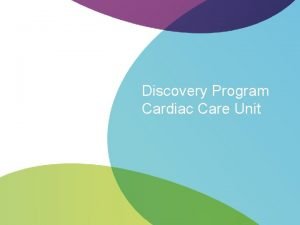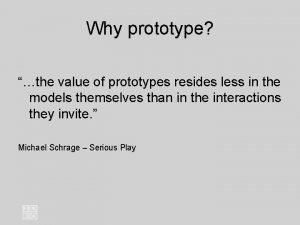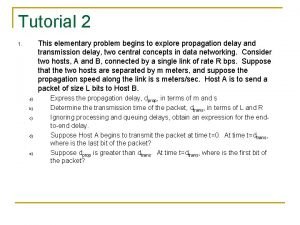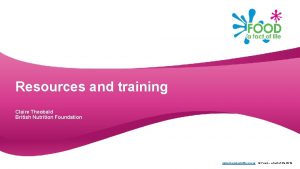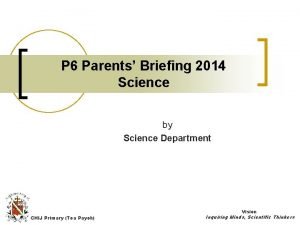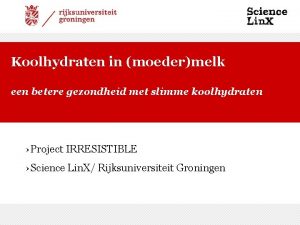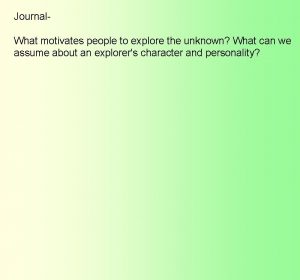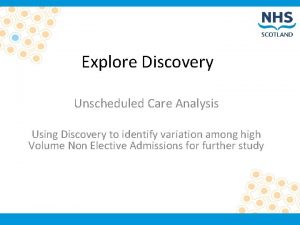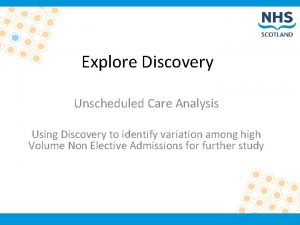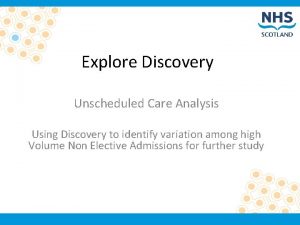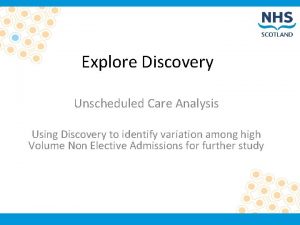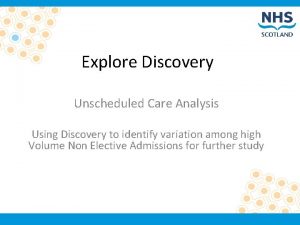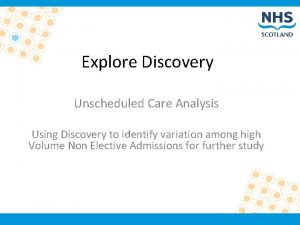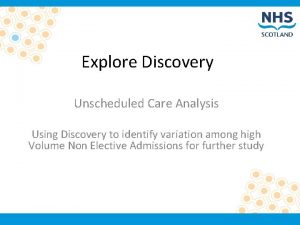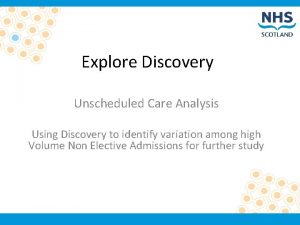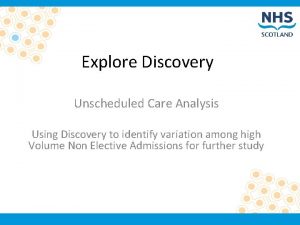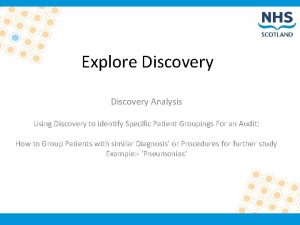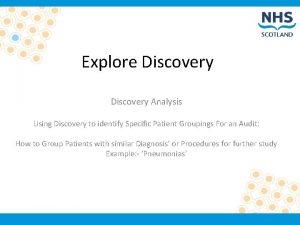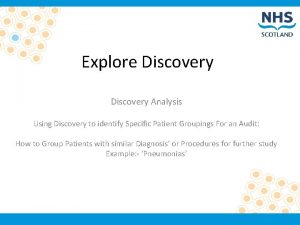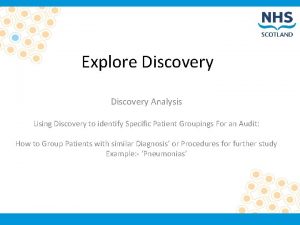Explore Discovery Unscheduled Care Analysis Using Discovery to














- Slides: 14

Explore Discovery Unscheduled Care Analysis Using Discovery to identify variation among high Volume Non Elective Admissions for further study

Methodology • Identified variation of Non Elective Admission/bed day rates by HB of Residence in Discovery at Level 1. (Slide 4) • Investigated this further by specialty which is available at Level 2. (Slide 5) • Used this information to identify what the high volume diagnosis are that are contributing to the admission and bed day rates within the Hospital Spell Analysis dashboard. (Slide 8 and 9). Information is available by individual consultant and also by procedure. • Analysed referral rates by Age/sex (Slide 6) and also local authority and GP practice to see if the information identifies any obvious outliers (Slide 10 and 11) • Analysed Hospital spell Average LOS for specific diagnosis to identify any variation for a specific high volume diagnosis (Slide 9)

Summary – Admissions and Bed Day Rate: Key messages • In this example Emergency Admission Rate is 115 for this HB, Scottish Average is 109. Emergency Bed Day rate is 885, Scottish Average is 754 (per 1000 population) (Slide 4) • To meet peer UQ this HB would need to reduce emergency admissions by 25, 000 and bed days by 256, 000 (Slide 4, Impact Analysis tab) • Admission and Bed Day Rate information is available at a specialty level (Slide 5 and 7) • For this HB Residents, their non elective Admission Rate for all Specialties is higher than the Scottish average for the majority of ages (Slide 6) • 5 most common diagnoses for all Non-Elective IP Hospital Spells are R 10 (Abdominal and Pelvic Pain), J 44 (Other COPD), J 18 (Pneumonia), J 22 (Unspecified Acute Lower Respiratory Infection) and R 07 (Pain in Throat and Chest. In Discovery users can filter by specialty/consultant, etc (Slide 8 view for C 1 General Surgery) • In this example, These 5 diagnosis accounted for 17% of all Emergency IP hospital spell admission activity for this HB and Time period.

Discovery: Level 1 Overview –Residence : Health Board and Impact Analysis Tab The indicator ‘Emergency Admissions Rate (Residence)’ identifies the standardised rate for Emergency admissions. Benchmarking available against Peers. Time Trend shows how rate is changing over time compared to the Peer average. The impact Analysis tab states by what the health board would need to reduce Non-elective Admissions and Bed Days to reach the UQ of their Peers. Time Trends in this workbook provides comparison against Peer UQ rate. A specialty split is not available on this Dashboard but is available at Level 2. User cab navigate to the Level 2 dashboards via the arrows.

Discovery: Level 2: Admissions Residence: Specialty Admissions per 1, 000 population residence From the previous view, have proceeded to level two: Admissions Residence. 1. Selections made on the filters. 2. The bottom table identifies the crude admission rate by specialty, including Bed Day Rate. Note some grouped Admission Conditions are also provided. 3. This dashboard is based on Continuous IP Length’s of Stay. Specialty is taken from the discharging episode of the CIS, and type of admission is taken from the 1 st episode of the CIS. At Level 2 in Discovery data is crude, no Standardisation has been applied

Discovery: Level 2: Admissions Residence: Demographic tab Admissions per 1, 000 population residence 1. Selections made on the filters. 2. From the radio buttons list at the right hand side of the column chart, select analysis. In this example the differences for Admission Rates By Age is shown, with a comparison against the peer rate. This is for all ‘specialties’, not individual specialties. It can be seen that the Non Elective Admission Rate for this HB is generally higher than the peer average across all age groups. 3. Most dashboards are dynamic so selections made on one panel are reflected in the other panels

Discovery: Level 2: Admissions Residence: Impact Analysis Tab Admissions per 1, 000 population residence 1. The Impact Analysis tab allows the user to compare Admission Rates (or Bed Day Rates) 2. by a range of indicators and if the user hovers over any of the Bars in the chart a tooltip will appear that identifies what is needed to do to reach the UQ rate of their peers. User can immediately identify which specialties vary from the peer average 3. If user selects (or multi-selects) any of the specialties on the Bar Graph the trend chart at the bottom will update to reflect these selections

Discovery: Level 2: Hospital Spell Analysis: Diagnosis/Consultant Tab (Note activity based on HB of Treatment) In this dashboard the user can identify the most common diagnosis for the high volume (or any) specialties previously identified. NOTE information is based on Hospital Spells. 1. User chooses specialty/admission type the dashboard updates to show most common Diagnosis for this specialty. 2. Activity by Consultant and diagnosis is available. Note Consultant teams can be created if required. 3. User can flick between Activity (Hospital Spells) and Bed days

Discovery: Level 2: Hospital Spell Analysis: Hospital Tab (Note activity based on HB of Treatment) 1. The previous slide identified the high volume diagnosis for a specialty. Users can also filter on LOS Groups, to filter out long stays if required. 2. Hospital Summary Table compares hospitals within the health board for these diagnosis’. Scotland information also available. 3. LOS Distribution chart shows when patients are being discharged from Hospital. Useful to help investigate the scenario of Why is the variation in LOS between hospital s for the same diagnosis/procedure?

Discovery: Level 2 Local Authority Summary 1. Within the Local Authority Summary dashboard the user has the ability to get a breakdown for the patients by HB of Residence at Local Authority level in relation to the chosen indicator and specialty 2. Information is available as either a number or a rate. 3. Trend information is available that will highlight any changes over time HB A LA 4

Discovery: Level 2 GP Summary Dashboard: - GP Activity Tab The GP Cluster Summary Dashboard combines a number of indicator information that is available by GP practice. Activity information is available as activity or as a rate per 1, 000 of the GP population (based on latest GP List size) In this dashboard activity is linked to the specific GP practice recorded at the time of the activity, no matter where this activity takes place or where the patient lives. It can be seen that GP practices have a range of Emergency Bed day rates (per 1, 000). Comparisons available by GP practice, GP Clusters, HB and Scotland. Different charts are available including Trend information which can identified any changes over time.

Summary Information • • • Admission and Bed Day rate information is based on Health Board of Residence and is based on Continuous IP Stays. Hospital Spell Analysis information is available at a Hospital Spell level and is based on HB of Treatment. Diagnosis and specialty is based on the discharging (last) episode of the hospital spell. Procedure information is the 1 st main procedure recorded for that hospital spell Hospital Spells are calculated as an unbroken period of time that a patient spends within a hospital. A patient may change consultant, specialty or significant facility during a hospital spell. Data from Discovery can be extracted into excel format if required. Discovery can help benchmark activity and identify unwarranted variation. – Procedure/Diagnosis Information is based on the recorded Diagnosis Codes (ICD 10) and Procedure Codes (OPCS 4) for Hospital Activity. – The procedure diagnosis search function in the Hospital Spell Analysis Dashboard will search for words from the actual diagnosis or procedure descriptions. – User can identify procedures that have taken place for specific diagnosis, or vice versa diagnosis that have been linked to specific procedures.

Discovery Hints and Tips • The A to Z page : highlights all the information available in Discovery and provides • • • specific links to this information. Tool Tips: Throughout Discovery if the user hovers their cursor over any of the charts or data points a tool tip will appear with additional information Custom Views: Within each dashboard area it is possible to save specific visualisations (Custom Views) incorporating any filter selections the user has made. Pause button: - Clicking on the ‘Pause’ button allows users to make all of their filter selections at once rather than one at a time. Dynamic visualisations: Many of the dashboards in NSS Discovery are dynamic. This means that if you click on one area of a chart/table it will update the other areas/panels to reflect this choice. Exporting data from Discovery: To export data, select the chart or table containing the information you wish to export (by clicking on it), then click on the button (normally located near the top right of the dashboard) and choose the format you wish the data to be exported in. Metadata: - detailed metadata is available via the head icon at the top right of all dashboards.

For Discovery support and more information on accessing and using NSS Discovery, email us at: nss. discovery@nhs. net or visit our website: www. nssdiscovery. scot. nhs. uk
 Primary secondary tertiary medical care
Primary secondary tertiary medical care Discovery cardio care programme
Discovery cardio care programme Explore evolve validate prototype
Explore evolve validate prototype This elementary problem begins to explore
This elementary problem begins to explore Extraordinary country
Extraordinary country Www.careeronestop.org/explore careers
Www.careeronestop.org/explore careers Explore.ms
Explore.ms Claire theobald
Claire theobald Engage explore explain elaborate evaluate
Engage explore explain elaborate evaluate Engage explore explain elaborate evaluate
Engage explore explain elaborate evaluate What motivates people to explore
What motivates people to explore Europeans explore overseas
Europeans explore overseas Explore the alternatives in decision making
Explore the alternatives in decision making What drives people to explore?
What drives people to explore? Why did europeans begin to explore
Why did europeans begin to explore

